This recipe for Japanese hamburger steak was inspired by the ferris wheel in downtown Sapporo. Moments later, I noticed a hair piece a woman standing in front of me on the bus was wearing. The design was two adjoining circles with two different patterns made of brightly colored rings. Just before the bus stop where I got off, I decided to give what’s called ‘hambagu’ in Japanese, a new spin. It’s colorful, healthy, and fun.
Jump to Recipe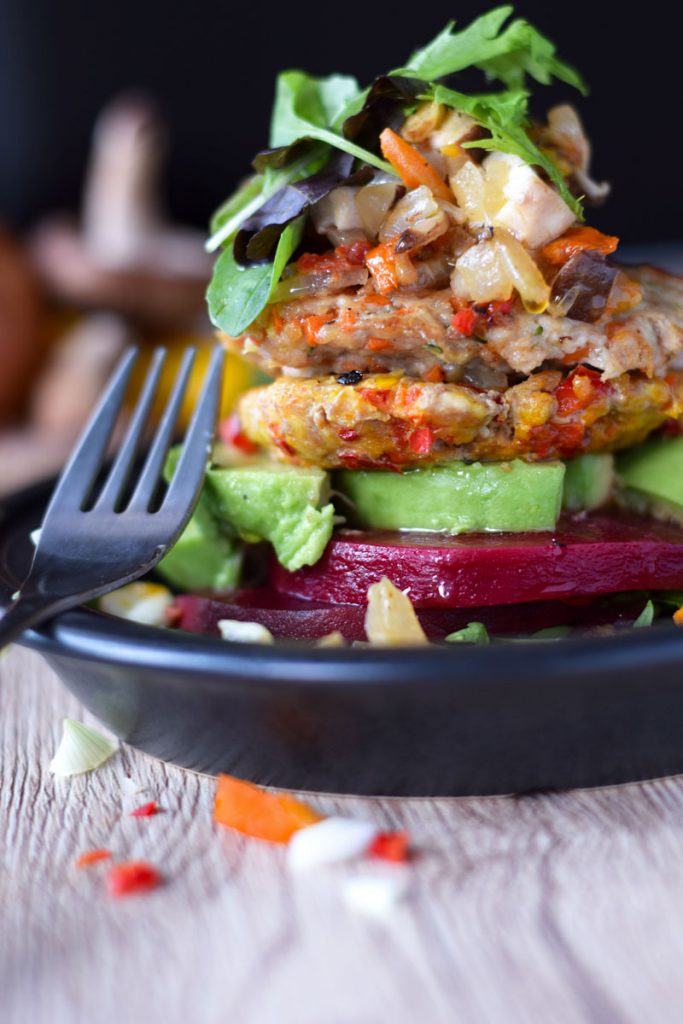
Hambaga vs. Hambagu
Even after years of living in Japan, I would get the words ‘hambaga‘ and ‘hambagu‘ mixed up. One has a bun and the other is just the meat patty, like a personal-sized meatloaf.
If you want a hambaga, with a ga, you can go to McDonald’s (pronounced ma-ku-do-na-ru-do).
If you want a beefy hamba-gu, smoothered in a gooey brown sauce, you won’t be able to pick it up to eat with your hands.
And if you don’t especially care for either one of those choices, then this recipe might be for you.
My new recipe is for healthy hambagu. There’s no bun, no ketchup, no mustard, no pickle… and no beef.
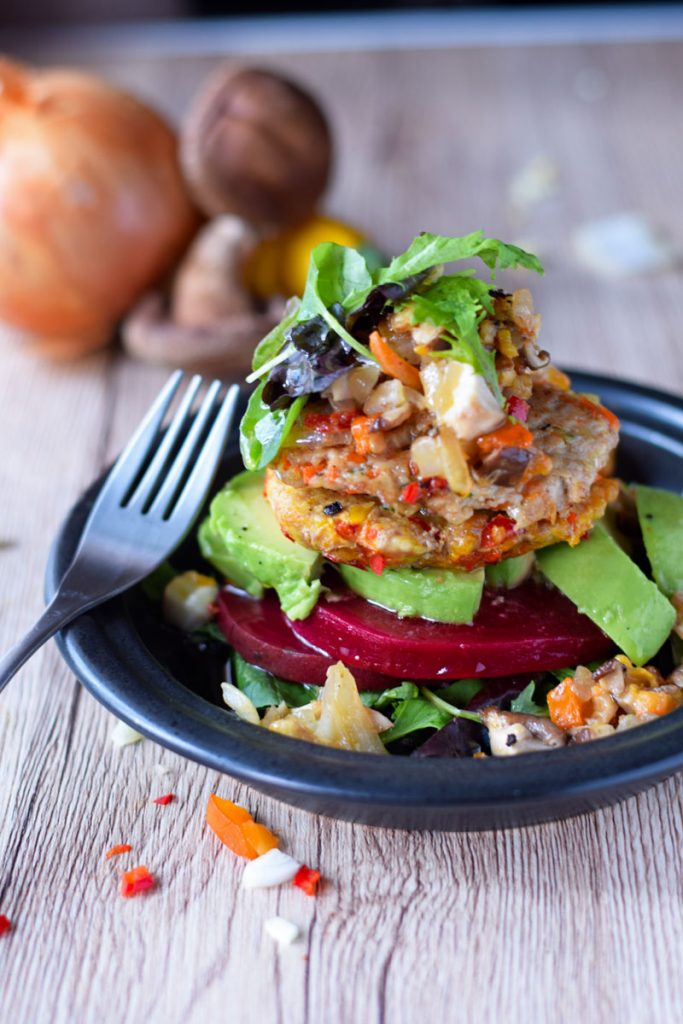
What is Japanese Hamburger Steak (Hambagu)?
Many describe hambagu as the Japanese version of Salisbury steak.
The memories I have of Salisbury steak are from school lunch and microwaveable TV dinners. “Mystery meat” served on a tray with gravy, instant mashed potatoes, and frozen green peas… If you grew in the US in the 1980s, you know what I’m talking about.
On the other hand, if you grew up in Japan, hambagu likely brings back fond memories from your childhood. Even imagining the smell that wafted from your mother’s or grandma’s kitchen makes me salivate.
Homemade hambagu meat patties are made from a mix of ground beef, ground pork, finely chopped onions, panko bread crumbs, egg, and seasoned with spices like nutmeg. The thick, circular patties are grilled on a skillet. The juicy meat is usually glazed with gravy, demi-glacé, or a tomato-based sauce. At restaurants, hambagu is often served on a hot plate with a side of warm, white rice, and cooked vegetables.
In Japan, hambagu is an economical way to enjoy a fancy “steak meal”. It’s easy to make at home on a weeknight after a busy day at the office. You can even buy mixed ground beef and pork for making hambagu at any supermarket in Japan.
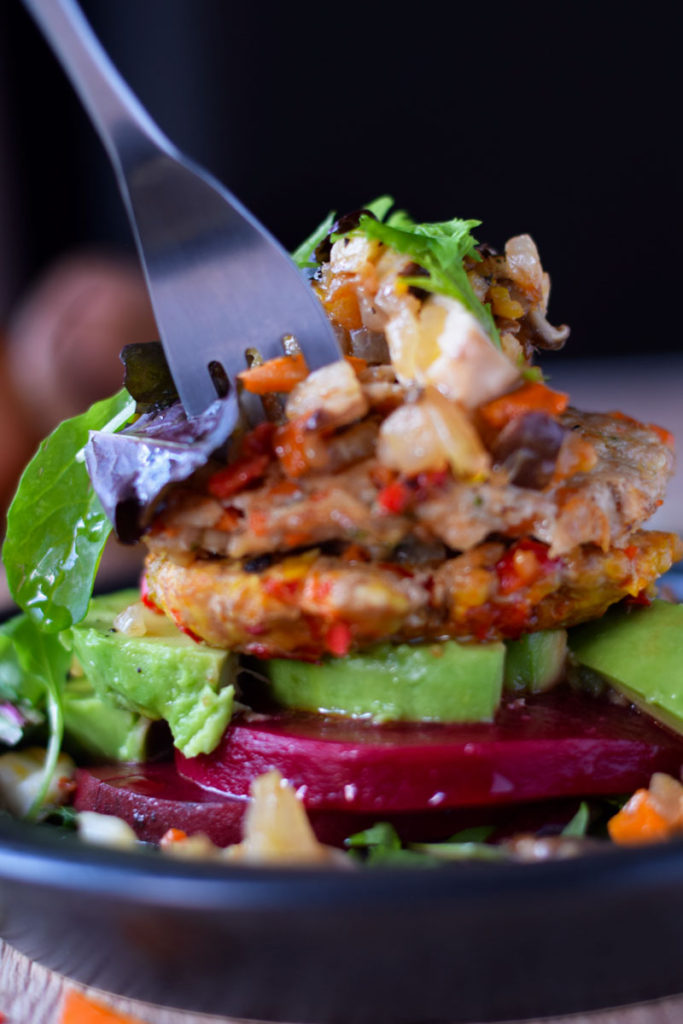
Hambagu- A New, Healthy Version for a Japanese classic
My new version of hambagu is still affordable and easy to make. To make it light and healthy, my recipe calls for ground chicken and there’s no gravy.
I added finely chopped vegetables to the minced, free-range chicken. I’m not a vegetarian, but I’m trying to reduce the amount of meat I eat at any one meal (no more than 100 – 120 grams).
Instead of making one thick patty, I split the amount of meat in half to make two thinner patties that I could stack.
This is no double-decker like what you’d get at Burger King or McDonalds. I added finely chopped yellow zucchini, red pepper, and turmeric to the burger that goes on the bottom. The burger on top has green zucchini, apple, carrot, and cinnamon.
Instead of gravy, I sautéed some chopped sweet onions, shiitake mushroom, persimmon, and walnuts. After my two burger patties got a head start on cooking, I filled in the rest of the pan with the makings for the topping.
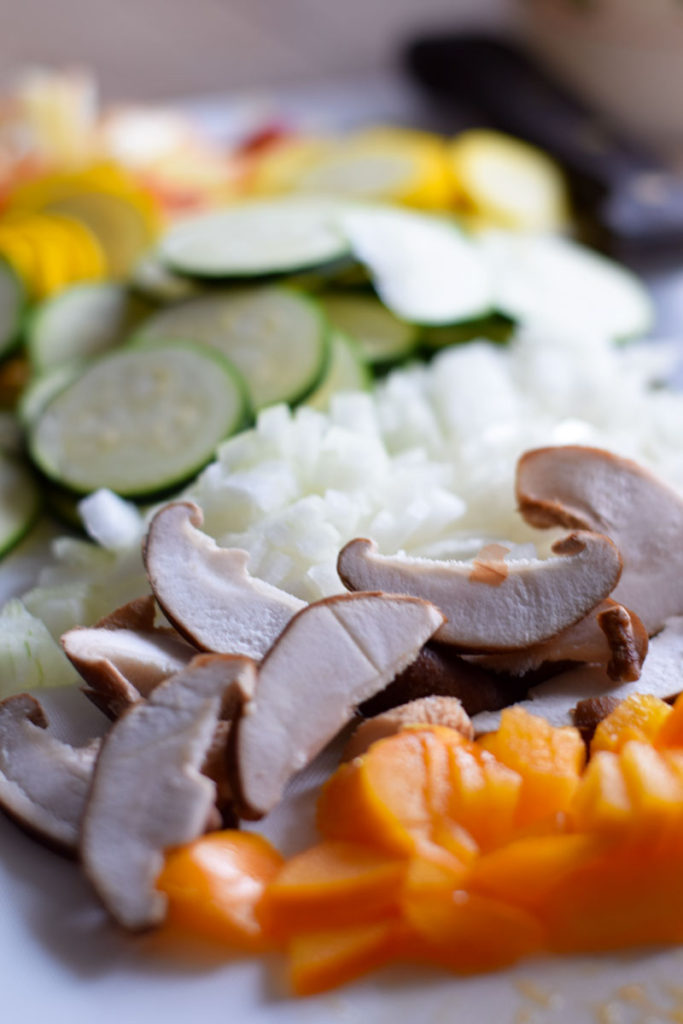
A variety of chopped vegetables– “eat the rainbow”
Last week, I sent my girlfriend a picture of this new burger creation. Her response was “Oishisou! (It looks good!) I want to try your rainbow hambagu.”
I promised her that I’d make it for her without the avocado. She can’t eat avocado.
You may have noticed that Japanese cuisine tends to be very colorful. If you look at bento meals, you’ll see all the colors of the rainbow. At one of my very first Japanese cooking classes in Tokyo, I learned that this was intentional.
The different colors in fruits and vegetables indicate to us that they contain a variety of nutrients, especially phytochemicals like beta carotene in carrots, the catechins in green tea, and the polyphenols in berries or red wine.
Healthy cooks in Japan know that eating a broad spectrum of colors is a good guarantee that your body is getting all the nutrition it needs.
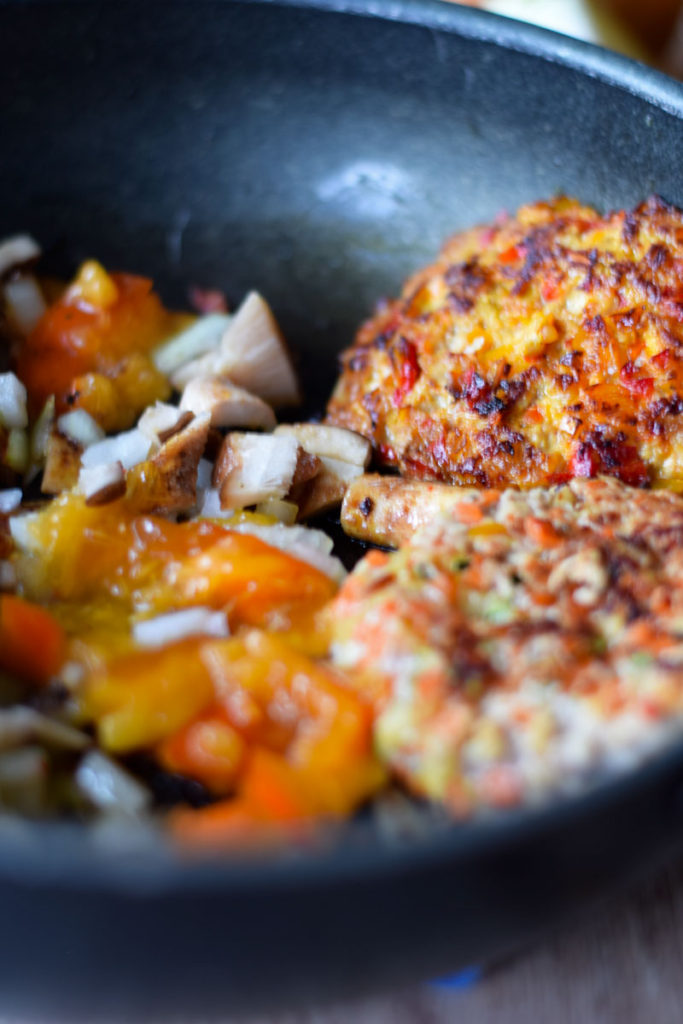
Important Tips for Making Japanese Hamburger Steak (Hambagu)
1. If your veggies are all chopped ahead of time, this recipe is a breeze to cook. If you can, I recommend doing the prep on a Sunday as a big batch and keep everything in the fridge. I use the leftover chopped vegetables to make omelettes for breakfast. The one exception is apple, which will turn brown after it’s chopped.
2. If you don’t have a lot of time for prep, you can always simplify the recipe by making one burger patty rather than two. Instead of adding a rainbow of different vegetables to the minced chicken, you can just pick one or two.
3. The secret to this hambagu turning out delicious is almost all in the quality of the ingredients. For the most part, I used all locally grown Hokkaido vegetables. Quality vegetables and chicken will make all the difference!
4. “If it looks good, it will taste good.” That’s a big part of how I decide which ingredients to use. When shopping for ingredients to make this recipe, I followed my gut (and my stomach!). If I could make this dish look good, somehow it ends up tasting how it looks: yummy in my tummy.
5. If you really want to have fries with your burger, I’m sure some roasted sweet potato fries would go really well with these autumn flavors.
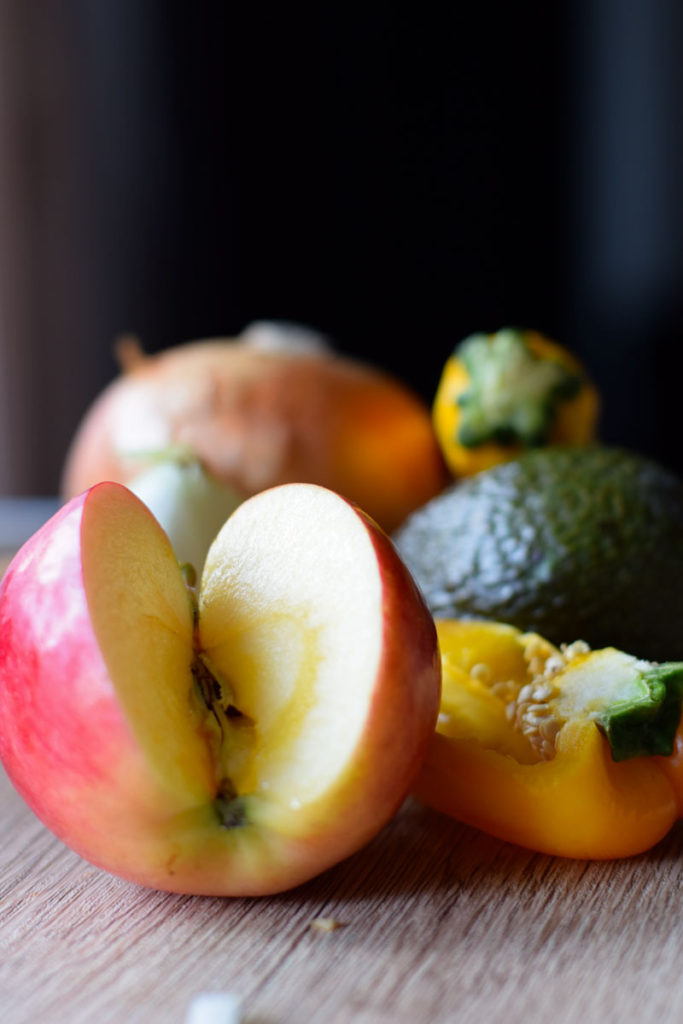
Seasonal Vegetables– Autumn
As I write this, I can see the leaves at the top of the gingko tree in front of my window are beginning to turn yellow.
When I was creating this recipe, I wanted to use autumn seasonal ingredients. As a color scheme, I loved the contrast of the beets’s deep purple with a few sprigs of mixed greens.
The orange persimmon, red apple, yellow zucchini– these colors reminded me of the leaves changing color and what I grew up eating at these time of year like apple cinnamon pie.
Right now, I’m imagining what this recipe would have looked like if I came up with it during the summer.
I intended this burger recipe to be more of an inspiration than something that’s replicated ingredient for ingredient. If you feel inspired enough to recreate this recipe using seasonal ingredients available in your country, I would love to see what you come up with!
How to make Japanese Hamburger Steak (Hambagu)
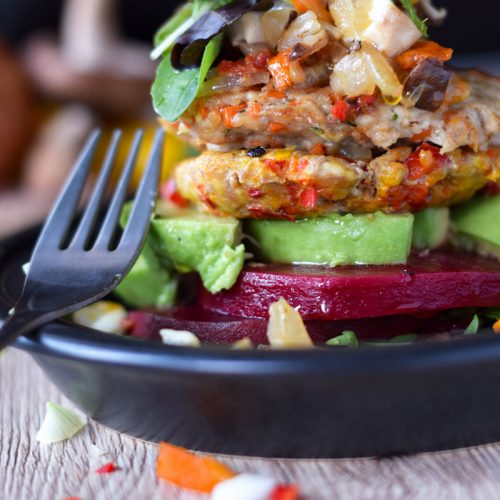
Japanese Hamburger Steak (Hambagu)
Ingredients
- 2 slices red beet
- 1 cup rice wine vinegar
- 120 grams minced chicken meat approximately ¼ pound
- 1 bag mixed greens baby leaf
- 2 teaspoon finely chopped red pepper
- 2 teaspoon finely chopped yellow pepper
- 1 teaspoon finely chopped yellow zucchini heaping teaspoon
- 2-3 dashes turmeric
- 2 teaspoon finely chopped carrot
- 2 teaspoon finely chopped green zucchini
- 2 teaspoon finely chopped apple
- 2-3 dashes ground cinnamon
- ⅙ chopped onion approximately ⅔ cup
- 2-3 small shiitake mushrooms
- 3-4 teaspoon chopped persimmon
- 1 teaspoon butter
- salt to season
- ground black pepper to season
Instructions
Pickled Beets
- Slice beet into slices approximately 6-7 mm thick.
- Fill small saucepan halfway with water. Turn stove on high. Cover pan with lid and bring water to a boil.
- Add beet slices to boiling water. Turn heat down slightly so the water doesn't boil over.
- Cook beets for about 5-7 minutes.
- Poke slices of beet with a chopstick or fork. When chopstick pokes through slices easily, turn off the heat and pour out the water.
- Set aside in bowl and let beets cool.
- Once beets are cool, put in a container with rice wine vinegar. Cover and keep in the refrigerator for at least 10-15 minutes.
Prep- Chopped Vegetables
- On a cutting board, finely chop yellow zucchini, red pepper, yellow pepper, carrots, green zucchini, and apple.

- Put each chopped vegetable into an individual bowl. Cover and keep in the refrigerator.

- Chop onion, shiitake mushrooms, and persimmon into small chunks (about 1 cm x 2 cm). Set aside in one bowl.

Prep and Cooking (to make Minced Chicken Patties)
- Turn stove on low to medium-low. Add yellow zucchini, yellow pepper, and red pepper to a small sauce pan or frypan. Stir with a spatula for about one minute to soften up the vegetables.

- Remove from pan. Use spatula to put chopped vegetables onto a small plate.
- Mix chopped vegetables with half of the minced chicken meat.
- Add 2-3 dashes of turmeric.

- Use your fingers to mix in the turmeric. Form a hamburger patty in the palms of your hands. Set aside.
- Repeat steps for the second burger patty with these ingredients: green zucchini, carrot, apple, and cinnamon.
- Turn stove on low to medium-low heat. Add butter to a frypan.
- When butter has melted, turn fry pan in circles to coat the bottom of the pan.
- Add both burger patties to the frypan.
- Cook for 2-3 minutes. Once the bottom side begins to brown, flip burger patties with a spatula. Move patties to one side of the pan.
- Add chopped onion to the other side of the pan. Stir regularly.
- Once onions begin to soften (approximately 3-4 on low heat), add shiitake mushrooms and persimmon.
- Continue to stir onion, mushrooms, and persimmon. Check on the burgers.

- Add 2-3 pinches of salt to the frypan (in the toppings and on top of the burgers).
- Once burgers are cooked all the way through (2-3 minutes), turn heat all the way down.
- Continue to cook the toppings until onions and mushrooms have a shiny glaze. Keep warm on low heat while you complete the next steps.
Plating
- Make a bed of mixed greens on the center of your plate.
- Place two slices of beets on top of the greens.
- Slice half an avocado while it's still inside it's skin. Slices should be about ½ cm.
- Use a spoon to loosen avocado flesh from it's skin. Using your hands, place avocado face down on the beets and gently lift off the skin.

- Press down lightly with your fingers to "collapse" the avocado (like a row of dominoes).

- Use a spatula to carefully place each burger on top of the sliced avocado.
- Use a spoon to carefully place mushroom, onion, and persimmon on top of the burger on top.
- Garnish with a few small baby leaves on top.

- Season with fresh ground pepper.
- Pour olive oil on top.

- Serve warm and enjoy!
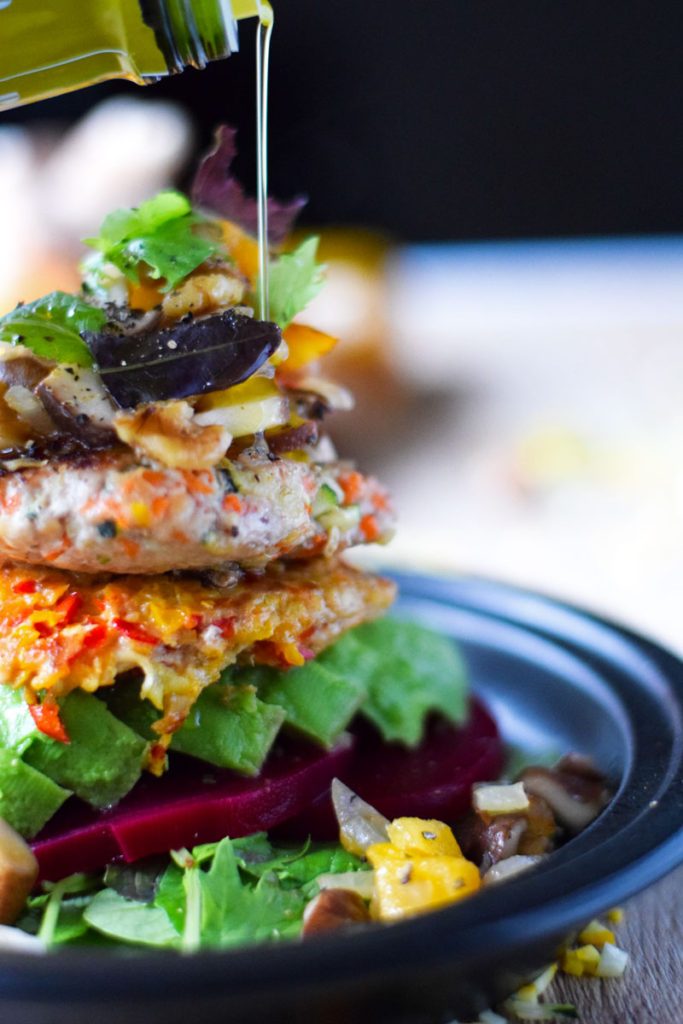
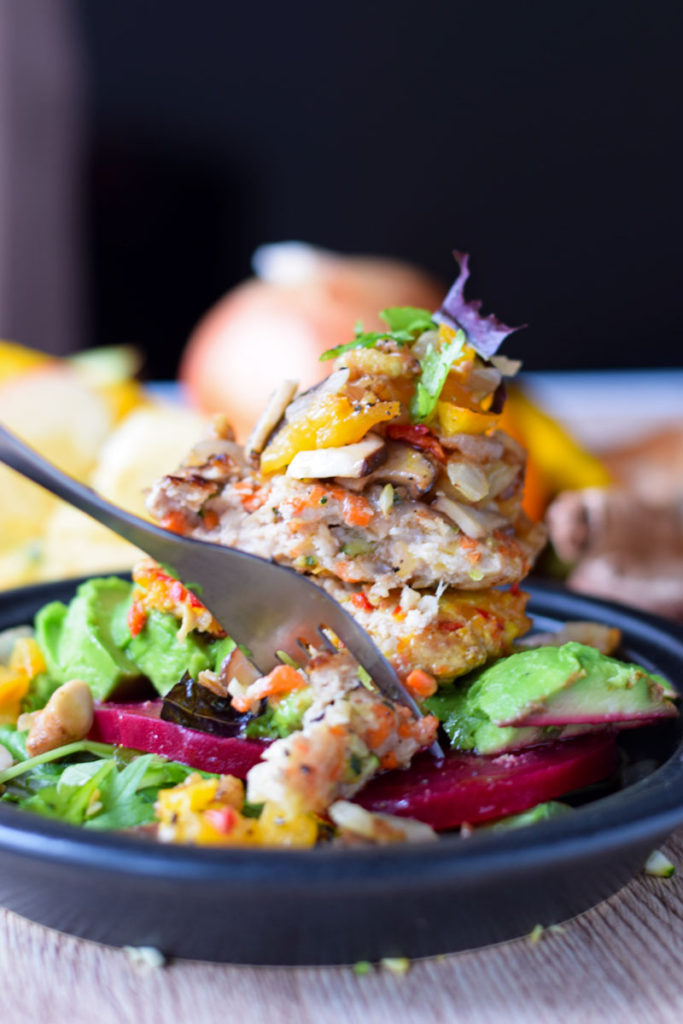
FREQUENTLY ASKED QUESTIONS
1) What is Japanese hamburg steak made of?
The key ingredients are ground meat and other ingredients like panko Japanese breadcrumbs, egg, diced onion, milk, salt, and ground black pepper.
It's usually made with 100% beef or a mix of pork and beef mince. At grocery stores you can buy a pork/beef mix. It's called aibiki niku (合いびき肉).
The tangy sauce is typically a mix of ketchup, tonkatsu sauce, and red wine. Worcestershire sauce can be substituted for tonkatsu sauce. Though, you may then want to sweeten it up with some added sugar.
2) What do you eat with hambagu?
In Japan, hambagu patties are often topped with fried egg, cheese, or Japanese style grated daikon radish with shiso (perilla) leaves. Wafu hambagu (Japanese-style) goes with a soy sauce- based sauce. Hambāgu with demi-glacé sauce and Teriyaki Hambāgu are other variations.
At the hambagu restaurant, Bikkuri Donkey, their hamburger patties come with white rice and a small salad made with thinly sliced daikon radish.
Hambagu is also commonly served with potato wedges, cooked vegetables like carrot, broccoli, green beans, corn, and cherry tomatoes. Sautéed onions and mushrooms also go well with hambagu.
Especially of the hambagu is served Japanese style with daikon oroshi (shredded radish), miso soup always goes well with Japanese rice.
3) Where did hambagu originate?
"Hamburg Steak" is originally German. Around the 18th century, people in Hamburg, Germany began serving patties made from minced meat in the shape of steak. The patties were grilled and served with gravy. German immigrants spread the dish to other countries, including the United States.
The exact origin of hambagu in Japan is not known. The hambagu became popular after World Word II, in the 1950s and 1960s. Meat became more readily available. It was served at Yoshoku restaurants. Yoshoku is Japanese Western food. Some examples of yoshoku dishes are omurice (omelette), doria, and Naporitan (Neapolitan) spaghetti (Guru Navi).
According to Wikipedia, hambagu steak in Japan likely dates back to the Meiji Era.
4) Why is hamburger steak so popular in Japan?
Hamburger steak became popular in Japan for several reasons:
- Simple and Easy: "Hambagu steak" is easy to prepare and can be served quickly. It's perfect for a week night meal for a busy family with young children.
- Affordable: Minced meat in Japan, especially a mix of ground beef and pork, is relatively inexpensive compared to other types of meat. Especially wagyu steak (cows raised in Japan) is very expensive. Especially for families on a strict food budget, hambagu is a lower cost meal that Japanese kids still love to eat.
- American influence: After World War II during the American occupation, Japanese was heavily influenced by American culture.
- Tastes: it's a favorite comfort food in Japan. For one, it's delicious! And I'm sure Japanese people have fond memories of eating hambagu as a child. Japanese food blogger, Namiko Chen, remembers helping her mom make hambagu many times.
5) What is the difference between hamburger steak and Salisbury steak?
Hamburger steak and Salisbury steak are very similar dishes. And both dishes come from the same origin: hamburg steak from Hamburg, Germany. Some people say they're basically the same thing, depending on the recipe you're using.
Salisbury steak is made from a mixture of ground beef and fillers like breadcrumbs, eggs, onion, and other flavors. The taste and texture is similar to meat loaf.
The meat mixture for Japanese "hambagu steak" usually contains panko breadcrumbs).
Hamburger steak is typically made with just ground beef, salt and pepper. It's pan-fried and usually served with gravy. Basically, there is less filler or no filler, just some seasoning.
I remember eating Salisbury steak growing up. We always had Salisbury steak with mash potatoes and gravy.
So if there is a genuine difference between the two, it's that Salisbury steak contains more filler like breadcrumbs.
6) What is hamburger steak called?
In Japanese, Hamburger steak is called hambāgu (pronounced hahm-bah-goo) or hambāgu sutēki. Hambāgu steak is a transliteration of the German city of Hamburg. Transliteration means writing words using a different alphabet. German Hamburg transliterates to ハンバーグ in katakana script.
For beginner Japanese speakers, it's easy to confuse the word for the American hamburger (hanbāgā) with hambāgu. A good way to remember the difference is that hambāgu is covered with goo-ey gravy. Now you'll never forget!
7) What's the difference between hamburger and hamburger steak?
Hamburger steak is a misnomer. The dish is made with minced meat, which means it's not actually steak. You could think of it as a budget-friendly imitation steak.
Hamburger steak is pan-fried hamburger meat. It's the same meat patties, just without the bun.
Hamburger steak is served with sides like grill vegetables, sauteed onions, and topped with gravy.
Author’s note:
This may likely be the last recipe I create sitting at this table. I sold it to a guy named Jon, who lives in Hong Kong. By as early as tomorrow, it will be in his new studio apartment in Rusutsu.
After a year of living in Sapporo, I’ll be moving back to Tokyo to look for work. This wasn’t part of my original plan. Heck, even this recipe for hambagu wasn’t part of my plan. The zucchini noodle tsukemen I was experimenting with just wasn’t working out.
I decided to take a step back and change directions.
I don’t know– if I hadn’t moved from Tokyo to Sapporo in the first place, I may not have even gone back to food blogging by now! One lesson I’ve learned during my time in Sapporo is to let go of my big plans…
Even my blog, I was trying to force it to make it work. I was trying to hack it, to improve at 10x speed.
It didn’t happen.
After taking a step back, I realized what I needed to do was to throw out my recipe for life and just follow my heart. That’s what I’m doing now. Who knows how it will turn out.
All I know is… When the gray clouds begin to clear, the sun shines through the cracks. That’s when rainbows appear.
Until we meet again, from Tokyo!

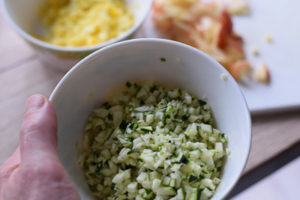
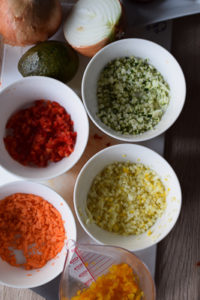
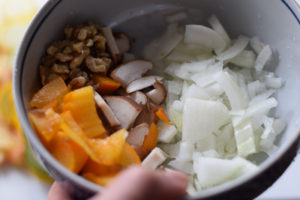
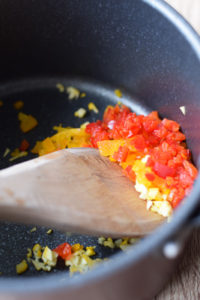
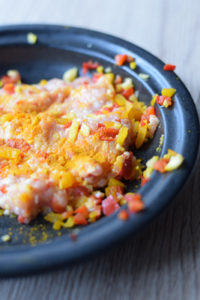
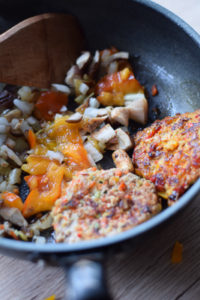
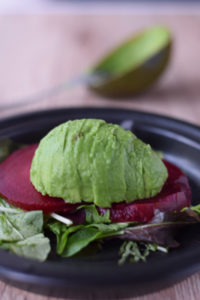
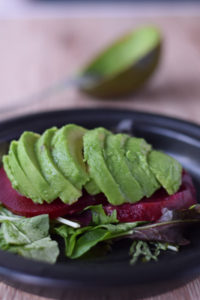
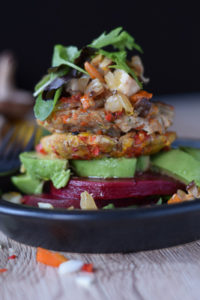
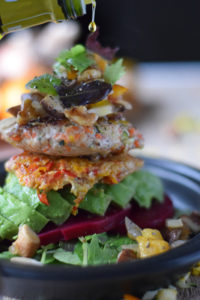





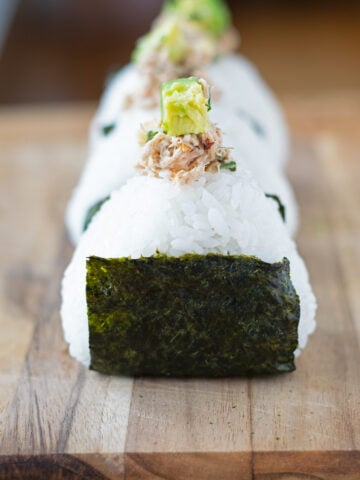

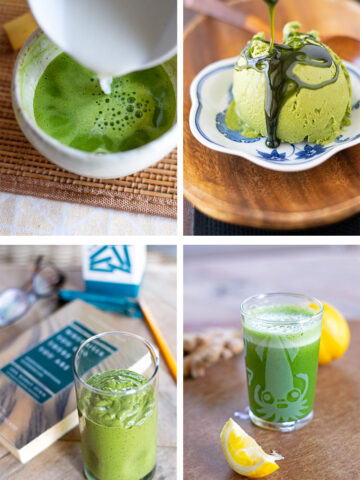
Leave a Reply